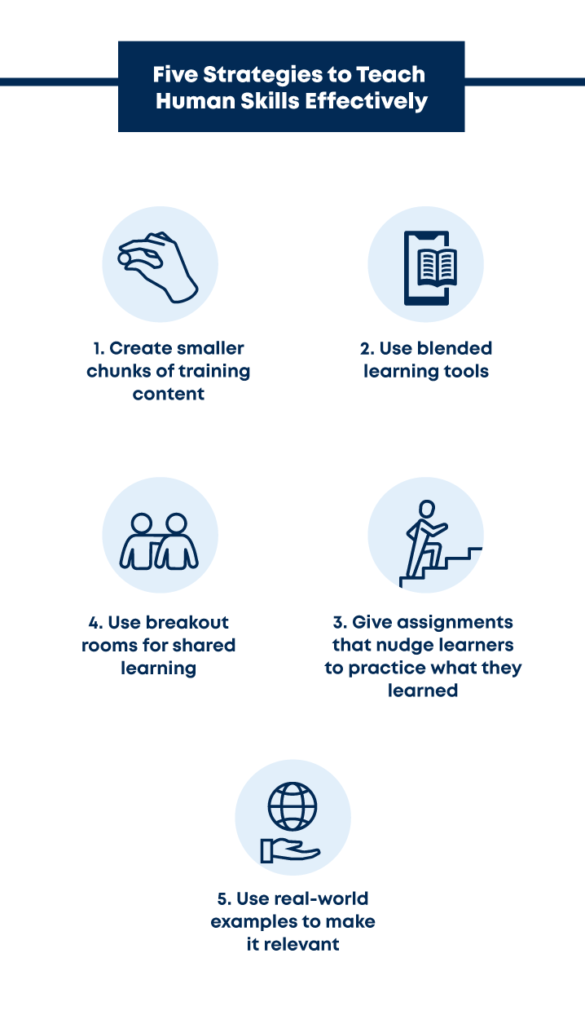Human skills, or what is commonly known as ‘soft skills,’ have always been essential in the workplace. Human skills refer to a person’s interpersonal skills as well as character traits. They reflect not only how effectively a person works with others but also how well they work independently. Human skills can range from communication, collaboration, and teamwork to empathy, critical thinking, problem solving, and time management.
Luckily for me (and for those who have worked with me), quite early in my career, I realized the significance of human skills. As a project manager, I often noticed that, in addition to submitting good quality work, what particularly mattered to clients was how promptly we communicated with them, how well we understood the project requirements, and whether we had an agile mindset to meet the changing needs of a project. I also found it interesting to see that it wasn’t necessarily the team members who were great writers or editors who thrived in the workplace; it was those who were resilient during difficult phases of a project, communicated clearly and promptly, and were curious and passionate about their work.
Since the COVID pandemic, human skills have become even more critical for businesses and employees. According to the World Economic Forum’s Future of Jobs report, in the coming years, complex skills such as critical thinking and problem solving, and skills in self-management such as active learning and resilience, will be some of the most crucial skills required in the workplace.
Human skills tend to be more difficult to teach than technical skills as they are more abstract and harder to quantify. And it is even more challenging to teach human skills to a workforce that’s now mostly virtual. As an L&D professional, I’ve often relied on five strategies to teach human skills.

Strategy #1: Create smaller chunks of training content.
According to an article on attention span by Time magazine, “people now generally lose focus after eight seconds, highlighting the [e]ffects of an increasingly digitalized lifestyle on the brain.” This means, in order for your learners to grasp the concepts covered in a training session, the content needs to be broken down into small, bite-sized chunks. Even though such a process may be time consuming, for the training to be effective, it is nothing less than a necessity.
Strategy #2: Use blended learning tools.
Learners are a mixed bag of individuals and each has a different learning mindset and style, so it’s wise to use a variety of learning tools to satisfy a diverse range of learners. Familiarize yourself with an assortment of tested, popular tools—ranging from graphics, videos, and whiteboards to polls, simulations, and learning trackers—that make learning engaging, fun, and impactful.
Strategy #3: Use breakout rooms for shared learning.
One of the best ways to teach human skills is to encourage participants to apply what they’ve learned during the training session. To do this, create breakout rooms with no more than 2-3 participants so that they are comfortable sharing the space to collaborate and learn from each other. Scenario-based activities usually work well for practicing human skills. For example, if you are conducting a session on Giving Feedback, create a scenario-based activity where one participant plays the role of someone giving feedback and another person acts as the receiver of the feedback. For increased difficulty levels, you could have the receivers act uninterested in or dismissive of the feedback—the participant giving the feedback would need to tailor their approach accordingly.
During the activity, join each breakout room to guide the learners and answer any questions. At the end of the activity, when learners are back in the main room, ask them to share their observations.
Strategy #4: Give assignments that nudge learners to practice what they learned.
Human skills need plenty of practice. This means, the participants’ learning process doesn’t end with the training session. In order to be able to incorporate new skills in their day-to-day life and work, they need to use them regularly. This is what makes post-training assignments and refresher sessions critical. As an assignment for a training on time management, you could ask participants to incorporate in their work one of the strategies they learned in the session, such as creating a daily schedule or using the Pomodoro method.
As a post-training assignment for a training session on communicating effectively with peers and stakeholders, ask learners to enact a communication-based role play with a family member, friend, or a peer from the training, and answer questions related to the scenario.
For post training assignments, learners need periodic support and guidance during their practice periods, so schedule refresher sessions where every few weeks participants share their learning experiences and you get a chance to address their questions or the challenges they may have faced during real-life implementation of the tips and techniques recommended during the training.
Strategy #5: Use real-world examples to make it relevant.
Each time I’ve conducted a training session, I’ve realized that the effectiveness of the session depends to a great extent on whether the content and supporting examples I use are relatable and apply to the work the learners do. More relevant content also mean higher engagement levels. For example, if I’m conducting a session on how to handle clients effectively for a team of software engineers, using scenarios from the finance industry could lower learners’ engagement levels because the examples would be unrelated to the day-to-day work that they do. Instead, if I use examples from a recent software industry project and put together a case study, the content is relevant and more impactful.
Teaching human skills virtually poses several challenges, ranging from limited sensory immersion (which face-to-face training provides) to difficulty in maintaining learner engagement throughout the training to ensuring the training translates into positive behavioral change and development for team members. “Research conducted with Fortune 500 CEOs by the Stanford Research Institute International and the Carnegie Mellon Foundation, found that 75% of long-term job success depended on people skills. Only 25% of success depended on technical knowledge,” according to an article in the American Management Association.
If we consider only the challenges human-skill trainings pose, it feels like a tall order. However, when we consider the positive impact, such trainings can have on businesses and team members, they’re worth every bit of the effort.
This article was originally published on https://trainingindustry.com/articles/remote-learning/5-strategies-for-teaching-human-skills-virtually/



